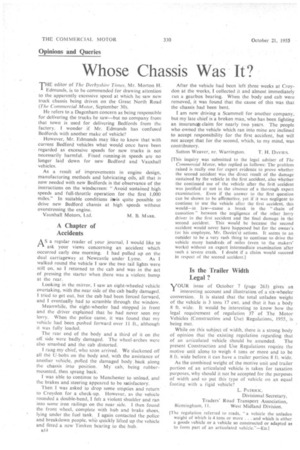A Chapter of Accidents
Page 48

If you've noticed an error in this article please click here to report it so we can fix it.
AS a regular reader of your journal, I would like to
ask your views concerning an accident which occurred early one morning. I had pulled up on the dual carriageway at Newcastle under Lyme. As I walked round the vehicle I saw the two tail lights were still on, so I returned to the cab and was in the act of pressing the starter when there was a violent bump at the rear.
Looking in the mirror, I saw an eight-wheeled vehicle overtaking, with the near side of the cab badly damaged. I tried to get out, hut the cab had been forced forward, and I eventually had to scramble through the window.
Meanwhile, the eight-wheeler had stopped in front and the driver explained that he had never seen my lorry. When the police came, it was found that my vehicle had been pushed forward over 11 ft., although it was fully loaded.
The rear end of the body and a third of it on the off, side were badly damaged. The wheel-arches were also smashed and the cab distorted.
I rang my chief, who soon arrived. We slackened off all the U-bolts on the body and, with the assistance of another vehicle, pulled the damaged body back along the chassis into position. My cab, being rubbermounted, then sprang back.
I was able to continue to Manchester to unload, and the brakes and steering appeared to be satisfactory.
Then I was asked to drop some empties and return to Croydon for a check-up. However, as the vehicle rounded a double-bend, I felt a violent shudder and ran into some iron railings on the near side. I then found the front wheel, complete with hub and brake shoes, lying under the fuel tank. I again contacted the police and breakdown people, who quickly lifted up the vehicle and fitted a new Tinaken bearing to the hub.
ti 1 4
After the vehicle had been left three weeks at Croydon at the works, I collected it and almost immediately ran a gearbox bearing. When the body and cab were removed, it was found that the cause of this was that the chassis had been bent.
I am now driving a Scammell for another company, but my late chief is a broken man, who has been fighting an insurance claim for nearly two years. The people who owned the vehicle which ran into mine are inclined to accept responsibility for the first accident, but will not accept that for the second, which, to my mind, was contributory.
Sutton Weaver, nr. Warrington. T. H. DAVIES.
[This inquiry was submitted to the legal adviser of The Commercial Motor, who replied as follows: The problem raised is really one for expert evidence to prove whether the second accident was the direct result of the damage sustained by the vehicle in the first accident, also Whether the continued use of the vehicle after the WI accident was justified or not in the absence of a thorough expert examination. Even if the answer to the first question can be shown to be affirmative, yet if it was negligent to continue to use the vehicle after the first accident, this would—in law—cause a break in the "chain of causation" between the negligence of the other lorry driver in the first accident and the final damage in the second accident. This would be because the second accident would never have happened but for the owner's (or his employee, Mr. Davies's) actions. It seems to an outsider to be a very rash thing to continue to drive the vehicle many hundreds of miles (even to the makers' works) without an expert intermediate examination after such a severe crash. I doubt if a claim would succeed in respect of the second accident.]




































































































